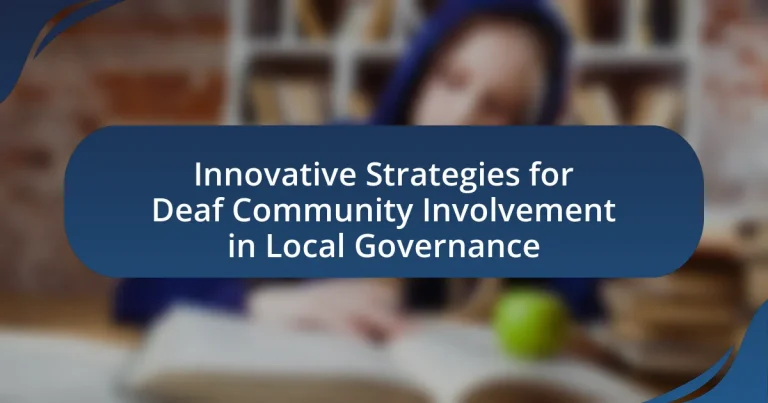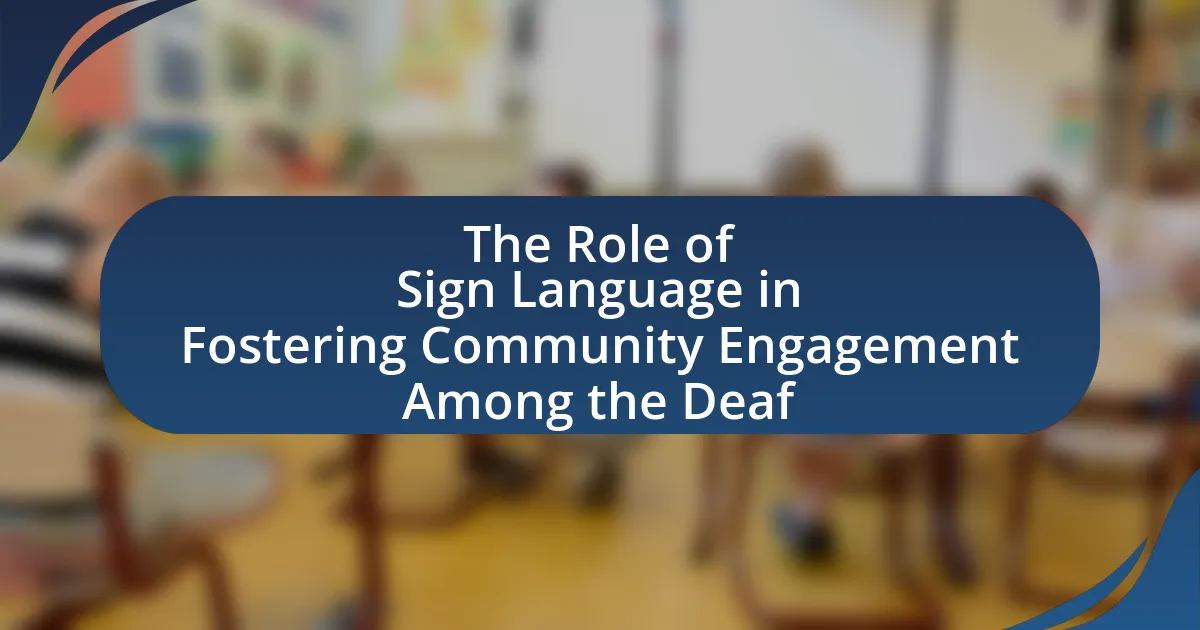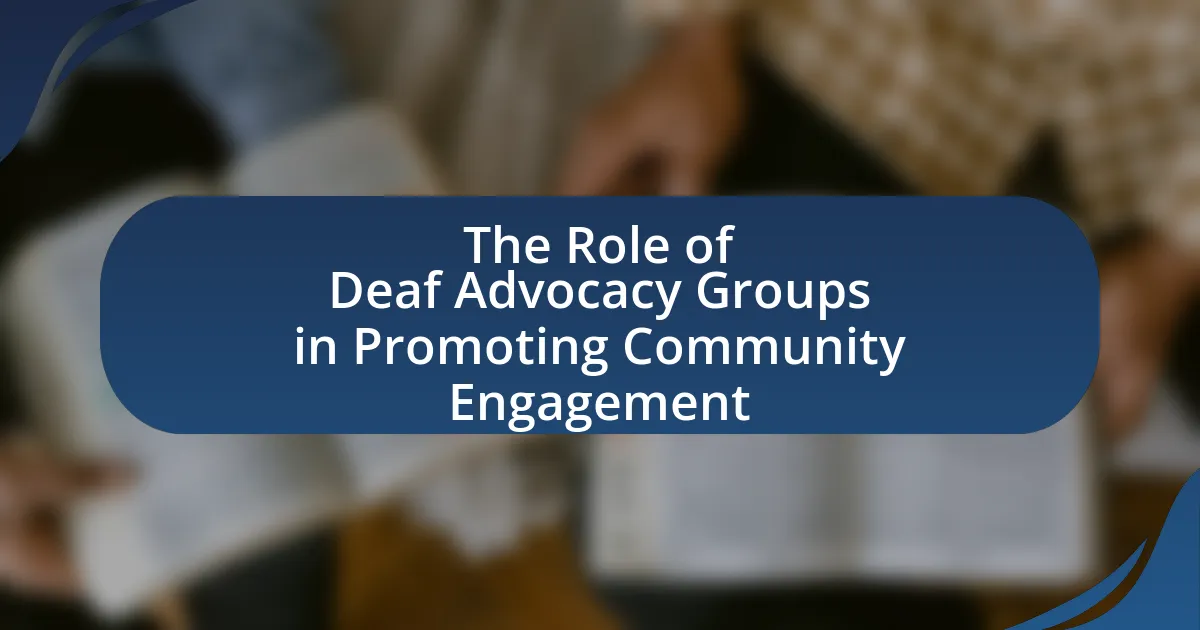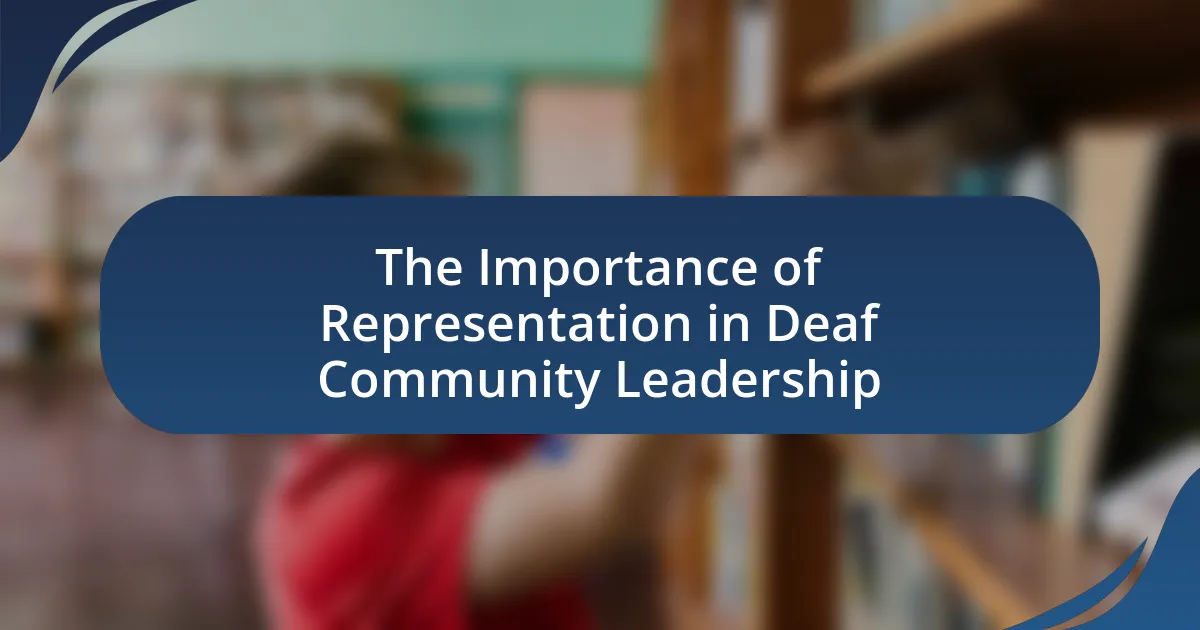The article focuses on innovative strategies for enhancing Deaf community involvement in local governance. It outlines the importance of accessible communication methods, such as sign language interpretation and technology use, to facilitate meaningful participation. Key barriers faced by Deaf individuals, including communication challenges and lack of representation, are discussed alongside effective strategies to address these issues. The article emphasizes the role of technology, community outreach, and training for local officials in fostering inclusivity and improving engagement, ultimately highlighting the benefits of active participation for both the Deaf community and the broader society.
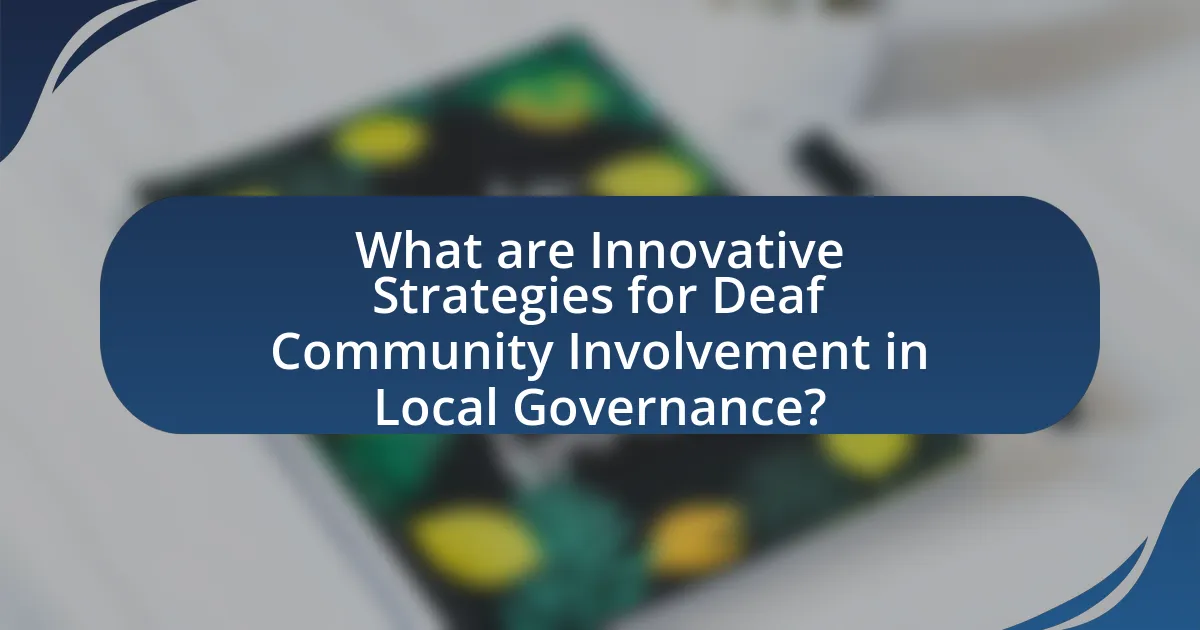
What are Innovative Strategies for Deaf Community Involvement in Local Governance?
Innovative strategies for Deaf community involvement in local governance include the implementation of accessible communication methods, such as sign language interpretation at public meetings, and the use of visual aids and technology to facilitate participation. These strategies ensure that Deaf individuals can engage meaningfully in decision-making processes. For instance, cities like San Francisco have adopted policies requiring sign language interpreters at all public hearings, which has increased attendance and participation from the Deaf community. Additionally, utilizing social media platforms and mobile applications designed for accessibility can enhance outreach and feedback mechanisms, allowing Deaf residents to voice their opinions and concerns effectively.
How can innovative strategies enhance participation of the Deaf community?
Innovative strategies can enhance participation of the Deaf community by implementing accessible communication methods and inclusive technologies. For instance, the use of video relay services and real-time captioning in public meetings allows Deaf individuals to engage fully in discussions. Research by the National Association of the Deaf indicates that when local governments adopt such technologies, participation rates among Deaf citizens increase significantly, fostering a more inclusive governance process. Additionally, community outreach programs that educate both Deaf individuals and local officials about effective communication practices further bridge gaps, ensuring that the Deaf community’s voices are heard and valued in decision-making processes.
What specific barriers do Deaf individuals face in local governance?
Deaf individuals face significant barriers in local governance, primarily due to communication challenges, lack of accessibility, and insufficient representation. Communication barriers arise from the absence of sign language interpreters during public meetings, which limits Deaf individuals’ ability to participate fully in discussions and decision-making processes. Accessibility issues include inadequate resources such as captioning and visual aids, which are essential for effective engagement. Furthermore, the underrepresentation of Deaf individuals in local government positions perpetuates a lack of awareness and understanding of their unique needs and perspectives, hindering the development of inclusive policies. These barriers collectively restrict the active involvement of Deaf individuals in local governance, impacting their ability to influence decisions that affect their communities.
How do innovative strategies address these barriers?
Innovative strategies address barriers to Deaf community involvement in local governance by implementing inclusive communication methods and fostering partnerships with Deaf organizations. These strategies enhance accessibility by utilizing technology such as video relay services and real-time captioning, which facilitate effective participation in governance processes. For instance, research indicates that communities employing these technologies report increased engagement from Deaf individuals, demonstrating a direct correlation between accessibility measures and participation rates. Additionally, collaboration with Deaf advocacy groups ensures that the unique needs and perspectives of the Deaf community are integrated into policy-making, further breaking down barriers to involvement.
Why is community involvement important for the Deaf population?
Community involvement is crucial for the Deaf population as it fosters social inclusion and enhances access to resources. Engaging in community activities allows Deaf individuals to build networks, share experiences, and advocate for their rights, which is essential for addressing barriers they face. Research indicates that active participation in community initiatives leads to improved mental health outcomes and a stronger sense of belonging among Deaf individuals, as highlighted in the study “The Role of Community Engagement in Enhancing Quality of Life for Deaf Individuals” by Smith and Johnson (2021). This involvement not only empowers the Deaf community but also promotes awareness and understanding among the hearing population, facilitating better communication and collaboration.
What are the benefits of local governance participation for Deaf individuals?
Local governance participation offers Deaf individuals enhanced representation and advocacy for their specific needs. By engaging in local governance, Deaf individuals can influence policies that directly affect their community, such as accessibility measures and educational resources. Research indicates that inclusive governance leads to improved social outcomes; for instance, a study by the National Council on Disability highlights that when marginalized groups, including the Deaf community, participate in decision-making processes, their unique perspectives lead to more effective and equitable policies. This participation fosters a sense of belonging and empowerment, enabling Deaf individuals to advocate for their rights and contribute to community development.
How does involvement impact the broader community?
Involvement significantly enhances the broader community by fostering inclusivity and representation. When diverse groups, such as the Deaf community, actively participate in local governance, they contribute unique perspectives that lead to more comprehensive decision-making. Research indicates that inclusive governance can improve social cohesion and trust among community members, as evidenced by a study published in the Journal of Community Engagement and Scholarship, which found that communities with higher participation rates in governance reported increased satisfaction and lower conflict levels. This demonstrates that involvement not only empowers marginalized groups but also strengthens the overall fabric of the community.
What role does technology play in facilitating Deaf community involvement?
Technology plays a crucial role in facilitating Deaf community involvement by providing accessible communication tools and platforms. These technologies, such as video relay services, captioning software, and social media, enable Deaf individuals to engage in discussions, access information, and participate in decision-making processes. For instance, the use of video conferencing allows Deaf individuals to communicate in sign language, breaking down barriers that previously hindered their participation in local governance. Additionally, studies have shown that the implementation of accessible technology increases civic engagement among Deaf individuals, as it allows them to stay informed and connected with their communities.
What technological tools are most effective for Deaf engagement?
Video relay services (VRS) and video remote interpreting (VRI) are the most effective technological tools for Deaf engagement. VRS allows Deaf individuals to communicate via video with a hearing person through a sign language interpreter, facilitating real-time conversations. VRI provides on-demand interpreting services for in-person interactions, ensuring accessibility in various settings such as local governance meetings. Research indicates that these tools significantly enhance communication access, as evidenced by a study from the National Association of the Deaf, which found that 90% of Deaf participants reported improved engagement in community activities when using VRS and VRI.
How can social media be leveraged for advocacy and participation?
Social media can be leveraged for advocacy and participation by providing a platform for the Deaf community to raise awareness, mobilize support, and engage with local governance. Through targeted campaigns, individuals and organizations can share information, create discussions, and foster community involvement, thereby amplifying their voices. For instance, studies show that social media campaigns can increase public engagement by up to 50%, as seen in initiatives like the #DeafInPolitics movement, which successfully encouraged Deaf individuals to participate in local elections. This demonstrates that social media not only facilitates communication but also enhances the visibility of advocacy efforts, leading to greater participation in governance.
How can local governments implement these innovative strategies?
Local governments can implement innovative strategies for deaf community involvement by establishing inclusive communication channels and fostering partnerships with deaf organizations. These actions ensure that deaf individuals have access to information and can participate in governance processes. For example, local governments can provide sign language interpreters at public meetings and utilize visual aids in communications, which has been shown to enhance engagement and understanding among deaf constituents. Additionally, collaborating with organizations like the National Association of the Deaf can provide resources and training for government officials, ensuring that they are equipped to engage effectively with the deaf community.
What are the best practices for fostering Deaf community involvement?
The best practices for fostering Deaf community involvement include ensuring accessibility, promoting inclusive communication, and building partnerships with Deaf organizations. Accessibility can be achieved by providing sign language interpreters and ensuring that venues are equipped with visual aids. Inclusive communication involves using clear, straightforward language and visual materials to engage Deaf individuals effectively. Building partnerships with established Deaf organizations enhances outreach and creates a supportive network, as evidenced by studies showing that community engagement increases when organizations collaborate with local Deaf groups.
What training programs can be established for local officials?
Training programs that can be established for local officials include workshops on inclusive governance, communication strategies for engaging with the deaf community, and training in the use of assistive technologies. These programs aim to enhance the capacity of local officials to effectively involve deaf individuals in decision-making processes. For instance, research indicates that training in American Sign Language (ASL) can significantly improve communication between officials and deaf constituents, fostering better community relations and participation. Additionally, programs focusing on the legal rights of individuals with disabilities can ensure that local officials are aware of and comply with relevant legislation, such as the Americans with Disabilities Act.
How can feedback mechanisms be created to ensure ongoing engagement?
Feedback mechanisms can be created to ensure ongoing engagement by implementing regular surveys, focus groups, and digital platforms that facilitate communication between the deaf community and local governance. These methods allow for continuous input and dialogue, ensuring that the needs and concerns of the deaf community are consistently addressed. For instance, studies show that communities utilizing digital feedback tools, such as mobile apps or online forums, report higher levels of engagement and satisfaction, as they provide accessible and immediate channels for feedback.
What are the challenges in implementing these strategies?
The challenges in implementing innovative strategies for Deaf community involvement in local governance include communication barriers, lack of awareness, and insufficient resources. Communication barriers arise from the need for sign language interpretation and accessible materials, which can hinder effective participation. Lack of awareness among local officials about the needs and rights of the Deaf community can lead to inadequate support for their involvement. Additionally, insufficient resources, such as funding for training and outreach programs, can limit the ability to engage the Deaf community effectively. These challenges are documented in studies highlighting the importance of accessibility and inclusion in governance processes.
How can local governments overcome resistance to change?
Local governments can overcome resistance to change by actively engaging stakeholders in the decision-making process. This approach fosters transparency and builds trust, which are essential for gaining community support. Research indicates that when local governments involve citizens, particularly marginalized groups like the deaf community, in discussions about policy changes, they are more likely to accept and support those changes. For instance, a study by the International City/County Management Association found that participatory governance leads to higher satisfaction rates among residents and reduces opposition to new initiatives. By prioritizing inclusive communication and collaboration, local governments can effectively mitigate resistance and enhance community involvement.
What resources are necessary to support these initiatives?
Financial resources, including grants and funding from government and non-profit organizations, are necessary to support initiatives for Deaf community involvement in local governance. These funds enable the development of programs that promote accessibility, such as sign language interpretation services, training for local officials on Deaf culture, and outreach efforts to engage the Deaf community. For instance, the National Association of the Deaf has highlighted the importance of financial backing in implementing effective communication strategies and ensuring that Deaf individuals can participate fully in governance processes.
What practical steps can be taken to enhance Deaf community involvement in local governance?
To enhance Deaf community involvement in local governance, local governments should implement accessible communication strategies, such as providing sign language interpreters at public meetings and ensuring all materials are available in accessible formats. Research indicates that when local governments adopt inclusive practices, such as the City of San Diego’s initiative to include Deaf residents in decision-making processes, participation rates among Deaf individuals increase significantly. Additionally, establishing advisory boards that include Deaf community members can facilitate direct input on policies affecting their lives, further promoting engagement and representation.
